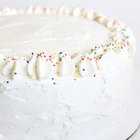
Frosting is essential to a cake. It traps in moisture, adds flavor and makes cake delicious to the eye and mouth. When applying frosting to the sides of your cake, consistency is key if you want it to stay in place and not peel away -- and possibly take part of the cake with it. The ingredients you use when making your frosting can also impact how stable it is. Therefore, using a sound recipe and applying it appropriately will keep your cake delightful and moist.
Making Frosting
Step 1
Use a buttercream frosting recipe that has equal parts shortening and butter. These ingredients together increase the melting point of your cake -- meaning your buttercream won’t go soft in temperatures over 80 degrees Fahrenheit.
Step 2
Avoid using low-quality or flavored vegetable shortenings. The added ingredients in these shortenings create an ultra-soft frosting that doesn’t crust over or hold its place on your cake.
Step 3
Make frosting to a medium consistency. Medium consistencies are ideal for cake surfaces because they’re smooth enough to spread, but thick enough to hold their place. A frosting that is too thin moves on the cake, which can cause it to slide from the cake and take portions of your cake with it. Test for a medium consistency by spreading the frosting in the mixing bowl with a spatula -- you want it to spread easily. When you lift away the spatula the frosting should stick to your spatula and easily hold its shape.
Applying Frosting
Step 1
Use the right tools for applying frosting. A general kitchen spatula is cumbersome and doesn’t allow you to smooth frosting on the sides of a cake thin enough to keep it from pulling the sides away. Use a cake or icing spatula -- preferably one with an angled edge -- or bench top scraper to apply the frosting.
Step 2
Chill your cake in the freezer for 15 to 30 minutes before frosting it. This helps tighten the crumb of your cake. Don’t apply frosting to a warm cake -- this softens your buttercream and might cause it to move.
Step 3
Mix in more powdered sugar to your buttercream if you notice it’s sliding from the sides of your cake as you apply it. Add in 1 to 2 tablespoons at a time until you get a stiffer consistency.
Step 4
Crumb coat your cake first. Do this by applying a thin layer of frosting to the top and sides of the cake. This layer traps crumbs and holds the cake in place -- preventing it from moving and tearing once you add the heavier layer of frosting. Chill your cake in the refrigerator for 15 to 20 minutes -- or until your crumb coat has hardened over. Apply your top layer of frosting.
Related Articles

How to Thicken Icing With Sugar

Proper Storage of a Carrot Cake

How to Troubleshoot Seven Minute ...

Can You Use Heavy Cream When Making ...

How to Decorate Cake Using Heavy ...
How to Make Homemade Frosting With ...

How to Make Cakes Like a Bakery

The Difference Between Whipped Icing & ...

What Can I Substitute for Butter When ...

Can I Use Raspberry Jelly as Cake ...

How to Make Buttercream Frosting Spread ...

How to Defrost a Frozen Cake With ...

How to Make Whipped Frosting Without ...

Can You Make a Boxed Cake Without ...

Do You Need to Refrigerate Whipped ...

How to Keep a Wedding Cake with ...

How to Make a Fake Wedding Cake

How to Put Artificial Flowers on Cakes

Can I Change the Color of Rolled ...

Can You Put Fresh Strawberries in a ...
References
Writer Bio
Shailynn Krow began writing professionally in 2002. She has contributed articles on food, weddings, travel, human resources/management and parenting to numerous online and offline publications. Krow holds a Bachelor of Science in psychology from the University of California, Los Angeles and an Associate of Science in pastry arts from the International Culinary Institute of America.
Photo Credits
Stockbyte/Stockbyte/Getty Images